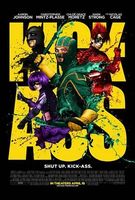Graphic Novel (On TV) Month: the Book vs the Film, Part 2
By Carey Toane
Last week I looked at how shifting formats from graphic novel to film changed the subtext of Ghost World and Persepolis. This week I’m taking on two British comics that have been made into films: Tank Girl and Kick-Ass.
Title: Tank Girl
Created by Alan Martin and Jamie Hewlett (who went on to create Gorillaz with Damon Albarn), Tank Girl was published serially in Deadline magazine from 1988 to 1995. Martin reportedly hated the film starring Lori Petty (!!), IceT, and Naomi Watts.
The comics are offensive and sexy and awesome and confusing as hell. Tank Girl sweats and swears and screws a kangaroo and all in a DIY Technicolor that dances around the page. It’s cartoony as hell but never caricatured, and instead maintains a refreshing unpredictability. I was also interested to learn that the subversive spirit was embodied in "Tank Girl nights" in the London lesbian scene, where the character was politicized in the fight against Thatcher’s anti-homosexuality legislation. So that's awesome.
Movie or book: Of all the books I’ve chosen, this film is maybe the best example of how format shifts affect subtext, because kangaroo porn. Hollywood is no match for Tank Girl. And so the counterculture pin-up punk is reduced to what I can only explain as Casey Jones without the Ninja Turtles. So yeah. Book.
Title: Kick-Ass
If most of these books lose something in translation to film, Kick-Ass reads like a script, made to be optioned. Written by Mark Millar and drawn by John Romita Jr, it is the most mainstream of the bunch with its misfit white boy anti-hero. It’s also the most current; the somewhat mundane plot is fed by memes and internet celebrity and something called MySpace.
All of this American Pie-style set up gets ripped apart by the arrival of 10-year-old Hit Girl. Armed with two Samurai swords she eviscerates the bad guys and outlives her daddy and just generally makes the whole thing interesting. I should add that the drawings are of the highest quality, carrying the reader through the bloodshed with grace.
Movie or book: Book. While the movie scores extra points for being shot in Toronto, and for casting primarily unknowns that don’t distract too much from the characters, it still adheres closely to the script, straying only to strip Hit-Girl of her swords (strange, in a post-post-Kill Bill world), and so adds little.
What did we learn from this little experiment? Graphic novel adaptations rarely live up to the originals, particularly when pencil lines are traded in for live action. Yet we still line up to see our heroes come to life.
Your CanLit News
Subscribe to Open Book’s newsletter to get local book events, literary content, writing tips, and more in your inbox
The views expressed in the Writer-in-Residence blogs are those held by the authors and do not necessarily reflect the views of Open Book: Toronto.
The views expressed in the Writer-in-Residence blogs are those held by the authors and do not necessarily reflect the views of Open Book.
Carey Toane is a librarian, journalist and poet. Her first collection of poems, The Crystal Palace, was published in 2011 by Mansfield Press. She lives in Toronto, where she is currently working on a collection of poems inspired by and dedicated to Twin Peaks. She is on Twitter at http://www.twitter.com/careygrrl
You can contact Carey throughout the month of May at writer@openbooktoronto.com



